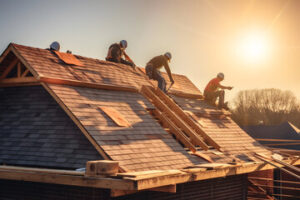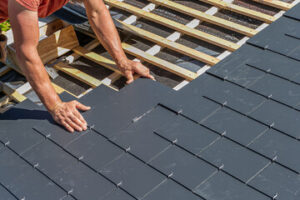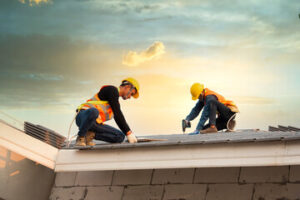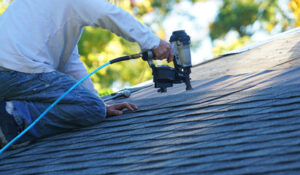Rain, wind and snow wage a constant war on your roof. Damage from a single trouble spot, such as missing shingles or water spots, can often be repaired without replacing the whole roof.
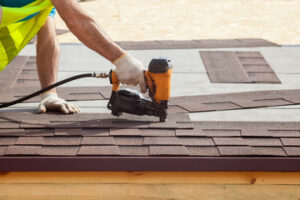
Conduct a visual inspection of your roof regularly. Look for leaks, sagging sections and any signs of rot or mold. Also, go in the attic to check for sagging wood and water stains. Keep reading the article below to Get a Free Quote Today.
The cost of roof repair varies based on the type and scope of the work, and where you live. Local labor rates, the availability of materials, and even local regulations or permit fees can impact overall costs.
Partial repairs can be less costly upfront than a full roof replacement, as they only replace the damaged areas. However, these repairs may not be as long-lasting or durable. If you opt for this route, be sure to factor in ongoing maintenance costs to ensure the repaired area stays strong.
Minor repairs include replacing missing or cracked shingles, addressing leaks from soffit vents or chimney flashing, and repairing sagging decking and underlayment. These repairs typically cost between $150 and $500. Moderate repairs, such as patching up leaks or removing and reinforcing the underlayment of the roof, can cost between $1,000 and $2,000. Major repairs, such as addressing extensive water damage or structural issues, generally require a partial tear-off and overlay.
Is it Worth a Professional Repair?
In general, it’s best to leave roofing work to the professionals. Not only can they ensure that the work is done properly, but they can also offer a warranty on their work. Plus, they’ll have a broader perspective on the condition of the entire roof and recommend any other work that might be required.
It’s also worth checking with your homeowner’s insurance provider to see if they cover the cost of roof repair. The amount that you pay toward your deductible (typically a percentage of the home’s insured value) will determine how much coverage you receive after the deductible is met.
The time of year that you schedule your repair can also have a significant impact on cost. Contractors are busier during the spring and summer, which can lead to higher rates and longer wait times. To save money, it’s best to schedule repairs in the fall or winter when contractors aren’t as busy and might offer more competitive prices.
Appearance
Dark streaks, spots, or extensive moss and algae growth on your roof are obvious signs of damage that require repair. These may be early indicators of leaks or a structural problem with the roofing materials, and can also lead to interior water damage. To prevent these issues, perform a visual inspection of your roof and clean it thoroughly. If necessary, use a moisture detector to detect hidden moisture within the layers of the roofing material.
During your inspection, you should look for damaged or missing shingles and the condition of the flashing (thin sheet metal around parts of the roof, such as vents, chimneys, and edges). You should also check for ponding water and the effectiveness of the drainage system.
Performing roof repair involves working at elevated locations, which poses certain safety risks for homeowners and professionals alike. Falling from heights can result in severe injuries and even fatalities. Understanding the potential hazards of this type of work is essential for creating a safer working environment and taking appropriate precautions to minimize accidents. These safety hazards include:
Environment
A roof repair may impact the surrounding environment, particularly if it involves removal of moss and algae. These organisms can trap moisture against the surface of the roof, leading to rot and other degradation. Regular inspection and removal of these organisms can prevent them from forming. In addition, a roof repair can help maintain the home’s energy efficiency. Gaps or leaks in the roof allow conditioned air to escape, which makes the HVAC system work harder to maintain a comfortable temperature. This can increase utility bills and result in a less energy-efficient home.
The environment also impacts the safety of individuals working on a roof. The roof repair process often involves work at elevated locations, which increases the risk of falls. Inadequate or improper fall protection equipment can lead to severe injuries. Additionally, working on a roof during a rainstorm can create slippery surfaces that increase the risk of slips and injuries. The presence of power lines near the roof can also pose a danger. Accidental contact with these lines can cause electric shocks and other serious injuries.
Working with hot materials, such as torch-applied membranes or tar, also poses a fire hazard. Proper ventilation and fire safety protocols are essential to minimize these risks.
Another environmental concern associated with roof repair is the generation of waste. This includes the disposal of demolition and construction materials, as well as the transportation to and from the worksite. These wastes produce significant emissions and should be properly managed to minimize their impact on the climate.
Moisture damage can also have negative effects on the home’s energy efficiency. Leaky roofs allow conditioned air to escape, forcing the HVAC system to work harder to maintain a desirable temperature. In addition, damp spots on the ceiling or walls can lead to rot and other structural issues. Removing visible moss and algae from the roof can help prevent moisture intrusion and extend the life of the roofing materials.
Whether a complete roof replacement is necessary depends on the extent of the damage and the age of the roof. In most cases, patching or reinforcing is sufficient for small areas of damage. However, replacing the entire roof with resilient materials is more effective for addressing significant weather damage and future-proofing against additional harsh conditions. Additionally, a full replacement will enhance the appearance of the home and can increase its resale value.
Insurance
Your roof is vulnerable to a wide range of potential damages, from sudden environmental events to gradual wear and tear. Understanding how homeowner’s insurance covers these issues can make the difference between a manageable repair bill and one that could drain your bank account.
Homeowner’s policies usually cover damage that occurs from sudden incidents, such as storm or falling branches. However, a leaky roof or prolonged moisture exposure can lead to mold and mildew growth, which not only affects your home’s interior but also may cause serious structural problems.
Whether you have standard homeowner’s insurance or a more comprehensive option, your policy should clearly state what coverage applies in the event of damage or total loss. Review the policy carefully to ensure that you understand what types of damage are covered and how your deductible and coverage limits apply. Keeping records of your conversations with the insurance company and any other documents related to your claim can help ensure a successful process.
There are two major types of coverage available to homeowners: replacement cost and stated value. Both have their benefits, but deciding which option best suits your needs depends on how much risk you are comfortable taking. Stated value coverage offers predictable payouts and lower premiums, while replacement cost coverage can offer peace of mind with full protection against the costs of replacing a damaged or destroyed roof.
If you suspect damage to your roof, it’s important to contact a qualified roofing professional right away for a detailed inspection and repair estimate. Remember that a successful claim can result in future rate increases, so it’s crucial to carefully consider your options before filing an insurance claim.
Keeping up with your annual roof inspections is another great way to reduce the need for repairs and protect your investment. It’s also a good idea to add additional coverage policies for special risks, such as flood or earthquake, and to consider reducing your deductible or increasing your coverage limits to mitigate the impact of a large claim.
